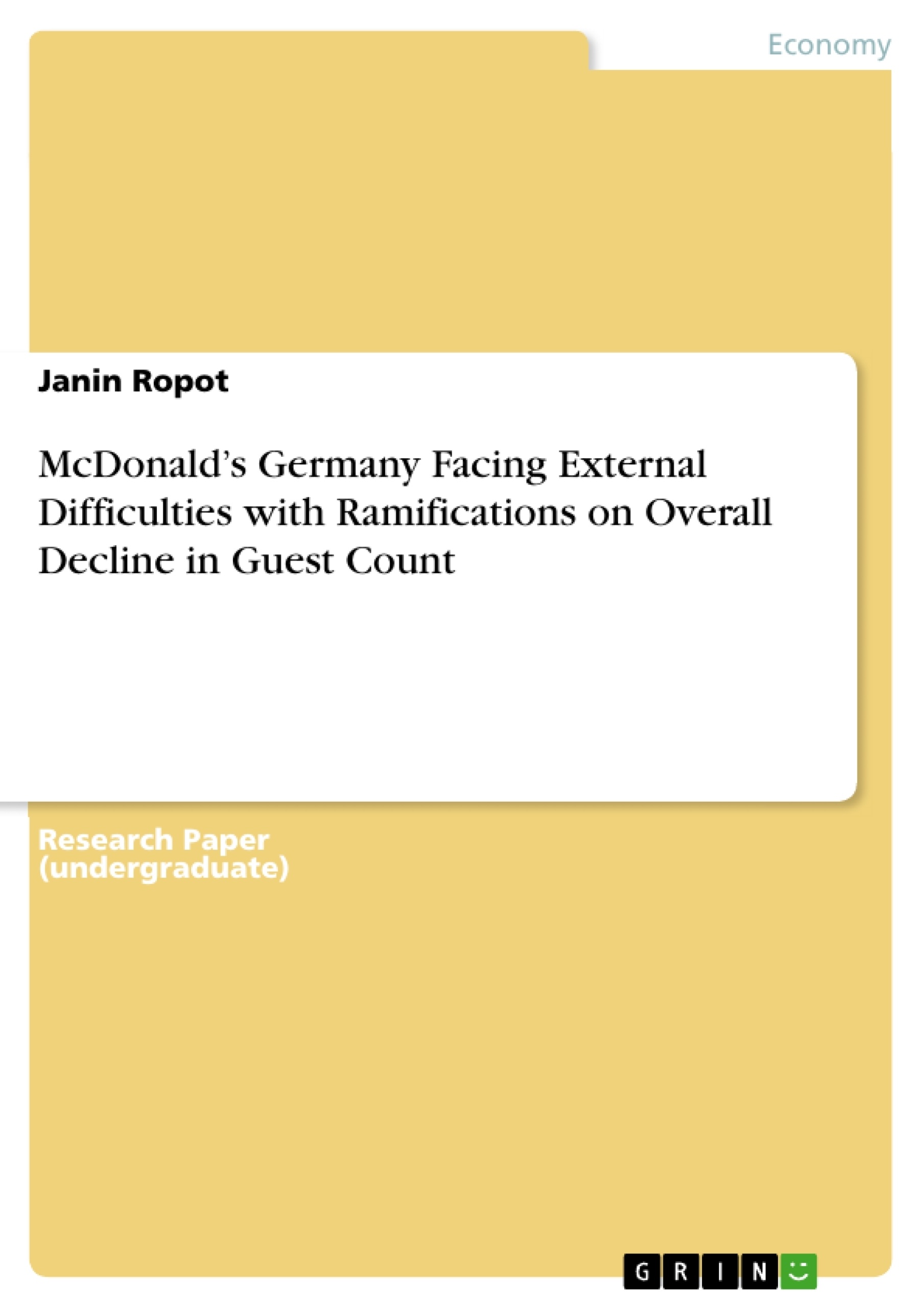The goal of this report is to provide a theoretical framework to analyse the current strategy of McDonald’s in the hypercompetitive fast-food industry of the German market and the decline of guest count. In order to analyse the external and internal influences, this report will commence with Porter’s Five Forces and the SWOT analysis. It will provide an in- depth description of the positioning strategy as well as an analysis of the marketing and operations departments. In the second part of the report the reader will also achieve understanding on how business procedures can be changed in order to keep McDonald’s of interest. This is followed by recommendations on how to improve the current situation and give an overview of McDonald’s alternative strategic approach to increase their market share as well as their profitability. The main idea of this report suggests McDonald’s to dip into the blue ocean strategy with an extended range of products. Healthier and individualized products and the extension of the beverage portfolio along with a more emotional marketing campaign is thought to enhance consumers’ loyalty. The research for the analysis comprises a qualitative approach based on industry experts, internal documentation such as McDonald’s financial statements, market reports and public announcements relevant to the strategy.
Table of Contents
- Executive Summary & Methodology
- Glossary
- Illustration Index
Objectives and Key Themes
This report analyzes McDonald's Germany's current strategy within the competitive German fast-food market and investigates the decline in customer visits. It utilizes Porter's Five Forces and SWOT analysis to examine external and internal factors influencing the company. The report also explores potential strategic adjustments to enhance consumer interest, improve the current situation, and increase market share and profitability.
- Analysis of McDonald's current strategy in the German market.
- Examination of external and internal factors contributing to declining customer counts.
- Evaluation of potential strategic adjustments to improve consumer loyalty and profitability.
- Exploration of a "blue ocean" strategy involving product diversification.
- Assessment of the effectiveness of McDonald's marketing and operations.
Chapter Summaries
Executive Summary & Methodology: This section outlines the report's objective: to analyze McDonald's Germany's strategy and the decline in customer visits. It details the methodology, which includes Porter's Five Forces, SWOT analysis, and an examination of McDonald's marketing and operations. The report proposes a "blue ocean" strategy—expanding product offerings with healthier, individualized options and a broader beverage selection—along with a more emotionally driven marketing campaign to enhance customer loyalty. The research is qualitative, drawing on industry experts, internal documentation (financial statements), market reports, and public announcements.
Keywords
McDonald's Germany, fast-food industry, declining guest count, Porter's Five Forces, SWOT analysis, strategic management, marketing strategy, operations management, blue ocean strategy, product diversification, customer loyalty, market share, profitability.
McDonald's Germany Strategy Analysis: FAQ
What is the main focus of this report?
This report analyzes McDonald's Germany's current market strategy, investigates the reasons behind declining customer visits, and proposes strategic adjustments to improve its performance and profitability.
What methodologies are used in this analysis?
The report employs Porter's Five Forces analysis, SWOT analysis, and an examination of McDonald's marketing and operations to understand the internal and external factors affecting the company. It also explores a "blue ocean" strategy as a potential solution.
What are the key themes explored in the report?
Key themes include analyzing McDonald's current German market strategy, identifying factors contributing to declining customer counts, evaluating potential strategic adjustments (including a "blue ocean" strategy), assessing the effectiveness of McDonald's marketing and operations, and exploring product diversification to enhance consumer loyalty and profitability.
What is a "blue ocean" strategy in this context?
The report suggests a "blue ocean" strategy as a way to improve McDonald's position. This involves expanding product offerings to include healthier, more individualized options and a broader beverage selection, essentially creating a new, less competitive market space.
What types of data were used in the research?
The research is qualitative and draws on various sources: industry expert opinions, internal documentation (such as financial statements), market reports, and public announcements.
What are the key findings or proposed solutions?
The report proposes strategic adjustments to improve customer loyalty and profitability. These include a "blue ocean" strategy (product diversification with healthier and more individualized options), a more emotionally driven marketing campaign, and a closer examination and potential improvement of their current marketing and operations.
What is included in the report's structure?
The report includes an executive summary and methodology section, a glossary, an illustration index, chapter summaries, and a list of keywords related to McDonald's Germany, the fast-food industry, and strategic management.
What are some of the key words associated with this report?
Keywords include McDonald's Germany, fast-food industry, declining guest count, Porter's Five Forces, SWOT analysis, strategic management, marketing strategy, operations management, blue ocean strategy, product diversification, customer loyalty, market share, and profitability.
- Quote paper
- Janin Ropot (Author), 2013, McDonald’s Germany Facing External Difficulties with Ramifications on Overall Decline in Guest Count, Munich, GRIN Verlag, https://www.grin.com/document/263915



